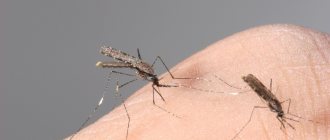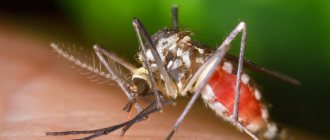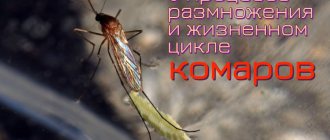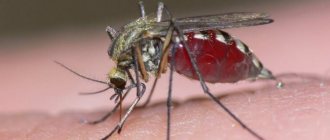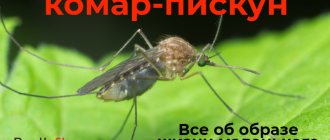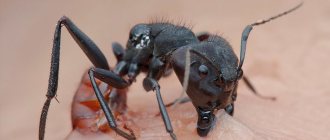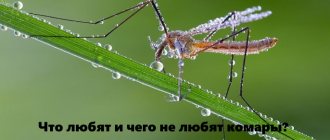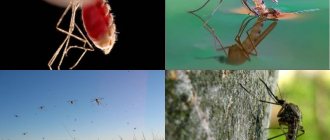On a summer evening you really want to have a barbecue in the yard or garden. But such events are often marred by large concentrations of buzzing mosquitoes.
They seem to fly right next to our ears. But why do they make that annoying buzzing sound? And how to escape from their bites in the summer?
“The buzzing in the ear is basically a side effect of the mosquito's wings beating,” said Michael Riehle, professor of entomology. “The sound doesn't have a wide range, so you notice it most when insects fly directly over your ear.”
Interesting facts about mosquito squeaks
Few creatures on the planet have the opportunity to boast of finding mention in the literature about radio engineering. Along with the bat, the mosquito is related to them. It is famous for its characteristic itching, which is used:
- For popular comparisons, examples in acoustics. It is present at the beginning and end of acoustic tables.
- To determine the hearing threshold. The sound power generated by the insect is distributed over a sphere with a radius of 2 meters. Squeak power per 1 sq. m of the surface of such a sphere - the area of the input canal of the ear - is 250 watts. The mass of air driven is approximately 44 kg.
- For simulation in danger signaling devices at military installations.
Mechanism of sound appearance
The squeak of a mosquito is familiar to everyone - extremely thin, annoying, irritating. Warns that at the slightest opportunity a bite will follow. It would be much more profitable for a blood-sucking creature to approach the victim silently, but the parasite cannot prevent the appearance of a special signal.
It does not produce sound from the mouth or nasopharynx. What a mosquito squeaks is of interest to many. The sound comes from its wings, which it flaps with extraordinary speed. When it comes into contact with air, a sound similar to squeaking appears. A peculiar buzzing sound begins to be emitted immediately with the first flap of its wings.
Interesting!
Why mosquitoes do not buzz, like many other insects, also has its own explanation. The wings are extremely thin and narrow, and the mosquito itself is miniature in size. In blood-sucking creatures, special halteres, not wings, are responsible for balance in the air. Therefore, the sound is produced more by these parts of the body than by flapping the wings at high speed.
Reproduction
The lifespan of mosquitoes depends not only on environmental conditions, but also on the sex of the individual. The female, under favorable conditions, can live 56 days. The young generation of mosquitoes is born after approximately 21 days. Initially, the males emerge, fly to the grass near the place where they lived as larvae, and wait for the females.
The active process of insect reproduction begins at the end of April, in May. Insects gather in flocks, fertilization occurs on the fly. Young females attract individuals of the opposite sex with a special squeak.
Mosquito breeding cycle
Within 10 days after fertilization, males die, females look for a victim to drink blood. This food source is necessary for the egg formation process to begin.
Having satisfied its nutritional needs, the insect looks for a place to lay eggs. This should be a body of standing water or a basement with running water. Less commonly, mosquitoes lay eggs in damp soil.
Inside the female, the young generation develops in about 3 days. Lays future larvae in groups or one at a time. Upon completion of this stage, the insect again looks for a victim to repeat the process.
A female mosquito makes a buzzing sound
The buzzing sound we hear is most likely made by a female mosquito. Males usually fly erratically and feast on flower nectar; they have no interest in people wandering around. The females, however, must find the blood they need to produce eggs. In fact, they have unique tools that help them identify their next victim.
"From a distance, females can capture the carbon dioxide that humans exhale," Riehle told Live Science. “This gas stimulates the female mosquito to start searching for the host, and she will fly back and forth to determine where it is coming from.”
5 things predicted in 2010 by writer Gary Shteyngart that came true
Turning Old Jeans into Long-Lasting Dinner Placemats
Spring Solstice (March 21): In the old days, people took knives to drive away troubles
Mosquitoes circle above our heads because this is where the source of carbon dioxide is located. The female senses body heat and then lands on the prey. She uses taste sensors on her legs to determine if a person or animal is fit enough for the next meal.
Buzzing or squeaking
These signals are generated by the movement of layers of air. There are many types of sound vibrations, differing in frequency and duration of sound, and the conditions in which they arise. The difference between the buzzing and squeaking of insects is hundreds of hertz.
What does a mosquito squeak?
A mosquito is more likely to produce a squeak than a buzz. It does not make this sound with a voice at all, contrary to popular belief, since the insect is completely deprived of it. Then what does a mosquito squeak? The squeak is generated by the rapid flapping of miniature wings.
Why the squeak?
Many insects buzz, but the mosquito squeaks. Why is that? The whole reason is the size of the insect itself. It is quite small in size, and its wings are too thin and narrow. Therefore, its flight generates a signal of the highest pitch, which is perceived as such a sound.
It squeaks and doesn't buzz
For comparison, the frequency of oscillatory movements produced by the wings of a mosquito reaches 1000 hertz or more, and by the wings of a bumblebee - 130-240 Hz. Therefore, they do not produce a thin sound, like a mosquito, but a bass sound. The flight of butterflies is completely silent, because the frequency of movements of its wings varies from 5 -9 Hz. The exception is a butterfly called the hawk moth, which creates a squeak.
Squeak squeak discord
Probably, many of us focused our attention on the fact that the “voice” of these insects sounds differently. The reason for this is the species and sex of individuals
The “voice” signals of females are much subtler than those of males. This characteristic sound helps to attract males during the mating season. And the singing of young individuals is not the same as that of older ones. Therefore, recognizing these differences, males choose younger females. The sound of males is a low buzzing itch.
Why does an insect make a sound?
Why does a mosquito squeak, because it is not beneficial for it to give itself away to the victim. It is much more useful for him to sneak up unnoticed. Then why do mosquitoes squeak?
The ability to fly or the desire to sing
It is known for certain that females use a characteristic itch to attract a male during mating periods, as already written above.
Other causes of mosquito itching
It's all about the halteres
But is this the only reason for mosquito itching? Why do mosquitoes squeak?
The fact is that in blood-sucking insects characteristic organs called halteres are responsible for balance. Their sound is associated with the activity of the organ of balance, and not at all with the wings.
By the way, halteres also used to have wings. This is evidenced by their shape, reminiscent of dumbbells or flasks. Their role can be compared with the role of a well-promoted spinning top. Its axis, maintaining a fixed orientation in space, allows you to maintain the balance of the entire structure.
Why does a mosquito make a high-pitched sound - entomologists explain
All flying insects stay in the air due to the constant back-and-forth motion of their wings, which creates lift. Butterflies have a wing area much larger than their body area; it is enough for them to flap them 5-10 times per second. This does not create much friction and the butterflies fly silently. The wings of flies, wasps and bumblebees are smaller than those of butterflies; they must be flapped 100-300 times per second. When it rubs against air, a characteristic bass rumble occurs.
The body of a mosquito, in addition to wings, is also equipped with their rudiments - halteres, which play the role of an organ of balance and allow it to hover over the skin of the victim before attacking. To keep the insect's body in the air, the thin wings and halteres need to beat 500 to 1000 times per second, resulting in the sound of the wings of a flying mosquito being barely tolerable to the human ear.
Fun fact: the sounds mosquitoes make are not a musical whim. They play a prominent role in the personal lives of insects. Females flap their wings more often than males, so the pitch of their flight is much higher. Actually, people only hear mosquitoes, since males do not show the slightest interest in bipeds. But mosquitoes can find “brides” by sound in complete darkness.
Larval development
The development rate of the young generation of mosquitoes depends on the water temperature. The optimal indicator is 15-20 degrees Celsius. The duration of development of larvae in the egg is from 40 hours to 8 days. They are born no larger than 2 mm in size. The body of the larva consists of a head, thorax, and abdomen. The future mosquito feeds on microorganisms in the water.
During the entire period of development, the larvae molt 4 times, constantly increasing in size. The cycle from egg formation to adult emergence lasts about 60 days. At the last stage of development, the larva turns into a pupa, shaped like a comma.
In the pupal stage, the mosquito develops from 2 to 5 days. During this time, serious changes take place inside. The pupa is extremely active, can go deep into the water, but periodically emerges to replenish oxygen reserves.
Upon completion of development, the mosquito breaks through the upper part, sticks out its head, then its chest. The last to be shown are the limbs. The body size of a regular mosquito is 4 mm. The insect is immediately ready for fertilization, so it begins an active search for a sexual partner.
Reasons for the effectiveness of ultrasonic repellers
Insects emit a characteristic squeak to convey to others a signal of danger. Fertilized females use sound to repel males. Ultrasonic repellers imitate danger signals - the flight of a dragonfly, the signals of a bat, and also the warning of a fertilized female. Simple devices are extremely effective in the fight against bloodsuckers, which once again confirms their important role in creating the squeak of mosquitoes.
In parallel with this, the characteristic sounds of mosquitoes indicate the approach of insects to the victim - a person, and risk being killed. The same feature notifies natural enemies about the location of food.
Life activity in early spring
Mosquito
Where mosquitoes come from immediately after winter with severe frosts is a mystery to some people. There is nothing special about this for specialists. With the onset of cold weather, fertilized females look for a secluded place for wintering. They climb into the cracks of outbuildings, houses, forest litter, and tree bark.
Mosquitoes overwinter in a state of suspended animation, but do not fall into deep hibernation. As soon as you bring the insect into a warm room, it immediately comes to life. In winter, insects live in damp basements, where the temperature does not drop below +12 degrees Celsius. However, reproduction activity is not so high. Only females can overwinter.
Who's the biggest?
The largest mosquito in the world is the Karamor. This is a real giant, which is the largest representative of its family. It lives in a temperate or humid climate, preferring forests and other tree plantations, near which there must be swamps or other bodies of water.
Karamora larvae are a real scourge of agriculture. Baby giants eat living plants and are therefore capable of destroying even large plantations. But adult individuals feed on nectar, and in some cases they can go without food for a long time.
The size of the caramor is impressive - its length can reach 6-10 cm! But at the same time, the main part of the body consists of long legs, and the body itself is quite small. This giant can be frightening when encountered, but it poses no danger to humans.
Is a smartphone against mosquitoes a trick for marketers or does it really work?
The market for mobile gadgets is incredibly diverse, but LG was able to surprise: a smartphone that repels mosquitoes went on sale. Mosquito Away technology works on the LG K7i model as follows: an ultrasonic module installed on the back of the smartphone emits a signal with a frequency of 30 kHz. A person does not feel them, because he is able to hear sound only in the range from 16 Hz to 20 kHz. Higher frequencies are called ultrasound, and can be detected by dogs, bats, and mosquitoes.
The creators of the model claim that a frequency of 30 kHz causes panic in mosquitoes, because the wings of dragonflies, the main fighters of bloodsuckers, vibrate in this range.
The anti-mosquito smartphone is intended primarily for sales in India - mosquitoes are so common there that they literally poison the lives of 1 billion 326 million inhabitants. In addition, they are the main carriers of malaria, and it kills about 2 million people on the planet every year. The device will not cost much - 7990 rupees, which is about 7 thousand rubles.
Does it really repel mosquitoes?
“In principle, the idea itself is correct, there is no sedition here,” says Emilia Narchuk, Doctor of Biological Sciences, Professor at the Zoological Institute of the Russian Academy of Sciences. — Ultrasound really repels mosquitoes, I’m familiar with such scientific works. I’m not sure that the vibration of the dragonfly’s wings plays any role here. Mosquitoes simply avoid sounds in a certain range. This effect has long been used in special devices that are similar in appearance to fumigators. Only in fumigators do insecticides evaporate, and ultrasonic devices emit corresponding signals. I know that such devices have been produced in a number of countries before. The only fundamentally new thing is that they are now combined with a smartphone. How effectively will they work? This can only be found out during testing. Because the signal must be strong enough. It is unclear whether the manufacturer provides this condition.
Isn't this harmful to health?
“In theory, no,” says the professor. — Because the ultrasound range is above the human hearing limit. But the question of whether smartphones themselves are safe enough has not yet been fully clarified. And how they will work in combination with an ultrasonic module... All this needs to be studied. Therefore, in my opinion, the most reliable and safe means of protection against bloodsuckers are still repellents.
SMARTPHONE SPECIFICATIONS
— Display diagonal 5 inches
— Quad-core processor MediaTek MTK6737M
— 2 GB of RAM and 16 GB of internal memory
- 2500 mAh battery
— Front camera 5 MP, rear camera 8 MP
— Can be equipped with a standard rear panel without the Mosquito Away function
